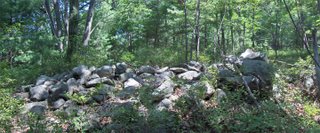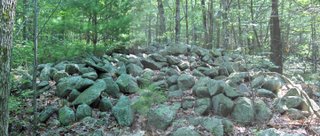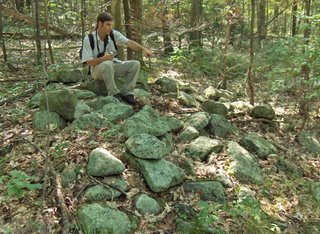
 From the start of the walk Bruce was arguing that the hollows scooped from the tops and sides of the piles were "thunderbird seats", hollows built deliberate into the original pile as places to sit. He pointed out that frequently there was a piece of quartz next to the hollow. He also pointed out that the hollow was often joined to the perimeter of the pile by an L-shaped "entrance".
From the start of the walk Bruce was arguing that the hollows scooped from the tops and sides of the piles were "thunderbird seats", hollows built deliberate into the original pile as places to sit. He pointed out that frequently there was a piece of quartz next to the hollow. He also pointed out that the hollow was often joined to the perimeter of the pile by an L-shaped "entrance". To me it seems more reasonable that we are looking at the remnants of an entrance passage into an inner chamber or crypt built into the pile. For some time now I have taken the view that these hollows are signs of vandalism: either the remnants of a hole dug into the pile or else remnants of a collapsed inner chamber/crypt that was looted. In fact I can't see how an L- shaped entrance would make sense as part of a "thunderbird seat".
To me it seems more reasonable that we are looking at the remnants of an entrance passage into an inner chamber or crypt built into the pile. For some time now I have taken the view that these hollows are signs of vandalism: either the remnants of a hole dug into the pile or else remnants of a collapsed inner chamber/crypt that was looted. In fact I can't see how an L- shaped entrance would make sense as part of a "thunderbird seat".[I had several other photos to post here but after 2 days of trying to get pics to up-load, I am sick of it. We'll have to live without them.]
One other possibility is that the piles were re-used: built for one purpose, damaged, and then converted into places to sit.
I'm inclined to agree with you Peter. We really should be finding damaged piles of various kinds. Early religious zealots would have viewed it as their duty to destroy any evidence of Native spiritualism. The looting of archaeological sites was a very popular pasttime throughout the 19th and into the early 20th centuries. Stones were removed for use in cellar holes, foundations, wells, and walls.
ReplyDeletePeople had so many reasons to destroy rock piles over hundreds of years that I believe your finds and your opinion fits perfectly with historical record.